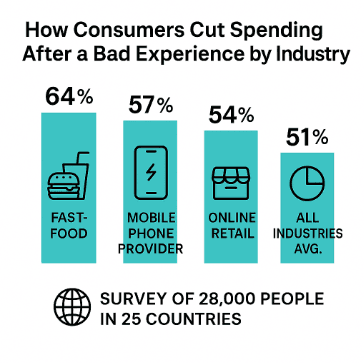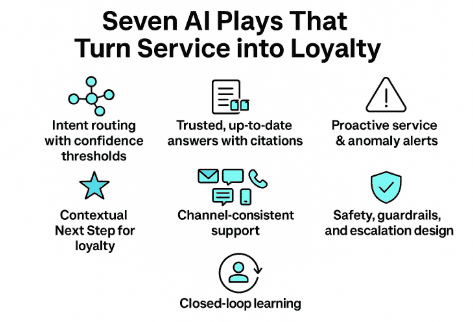- Global cost of poor service: around $3.5T (2024) → urgency to act.
- AI improves satisfaction and perceived efficiency; both drive loyalty, with satisfaction the stronger lever.
- Loyalty scales when AI nails five human dimensions: speed, simplicity, reliability, enjoyment, control.
- Start with seven moves: intent routing, retrieval-augmented answers, proactive alerts, contextual next step, channel-consistent support, safety/guardrails, and closed-loop learning.
“Efficiency attracts customers; satisfaction keeps them.”
Why this matters now
Poor customer service cost companies around $3.5 trillion in 2024 (Qualtrics XM Institute, 2024) annually. The takeaway isn’t just “go faster.” It’s to make service feel better—predictive, consistent, and human in all the right ways. In a hyper-competitive market, support is no longer reactive overhead; it’s a strategic driver of retention, revenue, and advocacy.
Studies show that AI-enabled support meaningfully increases both customer satisfaction and perceived efficiency, which together drive stronger loyalty. Recent research (Singh & Singh, 2024; Hussain et al., 2025) highlights that while AI enhances both factors, satisfaction remains the primary engine of loyalty, with efficiency serving as a valuable enabler. In short, AI builds loyalty not merely through faster service, but by elevating the overall customer experience.
What the global CX footprint really suggests
Customer service failure rates and revenue loss by industry are reflected in the following figure - % of customers or revenue affected after poor service (Qualtrics XM Institute, 2024).

A recent CX study (Qualtrics XM Institute, 2024) examines how consumers reduce their spending after a bad service experience, revealing significant differences across industries. The fast-food sector sees the sharpest drop at 64%, with other notable mentions including mobile phone providers at 57% and online retail at 54%, compared with an overall average of 51% across 20 industries surveyed. These results highlight the steep financial impact of poor service and show where targeted improvements can most effectively protect revenue.
With failure rates this steep, the opportunity isn’t just to repair what’s broken—it’s to reimagine service through AI-driven precision and personalization. Understanding where service fails is only half the story, and so the next step is knowing how AI can transform those weak points into loyalty wins.
Seven AI plays that turn service into loyalty

- 1
Intent routing with confidence thresholds
Map intents to expertise. Use model confidence to route complex issues to agents, simple ones to automation. Show customers the route (“I can fix this instantly” vs “Connecting you to a specialist”).
- 2
Trusted, up-to-date answers with citations
AI responses are based on your latest policies, documents, and products — with clear sources and “last updated” dates to build confidence and transparency.
- 3
Proactive service & anomaly alerts
Predict issues (shipping delays, billing anomalies) and notify customers before they contact you. Include one-click resolution choices.
- 4
Contextual Next Step for loyalty
After resolution, suggest value-building actions: extended warranty, account optimization, personalized tutorial—never generic upsells.
- 5
Channel-consistent support
Offer parity across chat, email, voice, and in-app. Use glossary controls and style guides to keep tone consistent.
- 6
Safety, guardrails, and escalation design
Block hallucinations with policy checks, red-team prompts, and sensitive-topic detectors. Handoff to humans when confidence is low or stakes are high.
- 7
Closed-loop learning with human feedback
- Tag each interaction with outcome labels (resolved/unresolved, effort, sentiment). Retrain regularly
- publish win stories to sustain momentum.
What “good” feels like to customers
- Speed: rapid triage and first steps.
- Simplicity: concise, jargon-free answers with visual steps.
- Reliability: consistent, accurate guidance with citations.
- Enjoyment: helpful tone, small wins celebrated.
- Control: easy escalation and transcript visibility.
Conclusion: Lead the AI loyalty revolution
AI-powered service isn’t futureware—it’s the operating system of modern loyalty. Every interaction is a moment of truth: fail once and customers leave; succeed consistently and they advocate. Brands that combine speed with emotional quality will retain more customers, grow LTV, and earn share-of-voice. The question isn’t whether to adopt AI—but how quickly you’ll scale it across the journey.